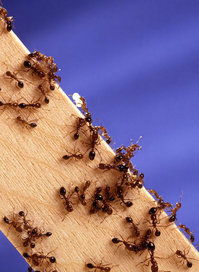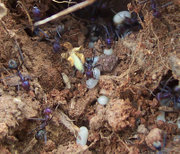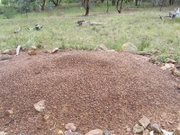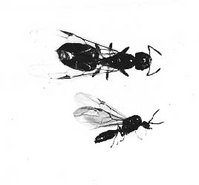Ant
Ants, one of the most successful groups of insects, are of particular interest because they form advanced colonies, and can constitute up to 15% of the total animal biomass of a tropical rainforest. more...
They belong to the order Hymenoptera, and are close relatives of the vespoid wasps. Ants appearing in amber found in central New Jersey are believed to be from the Cretaceous period. It is thought that they evolved from the wasps that had appeared during the Jurassic period. They are morphologically distinguished mainly by having six legs, sharply elbowed antennae, wingless worker caste, the first abdominal segment being fused with the thorax (= alitrunk or mesosoma), a wasptail like constriction between the first and second abdominal segment, and by having one to two bead-like round to scale-shaped pedicel formed from the second and third abdominal segments respectively, which in wasps are joined to the gaster.
Ants are also the only animals that possess the metapleural gland.
They can sense with organs on the legs, antenna, thorax and head which can detect sound vibrations moving through the ground. Also, they communicate with chemicals, having at least 10–20 chemical "words".
Most queens and males of ants have wings, which they lose after nuptial flight; however wingless queens (ergatoids) and males can occur. The currently known 11,836 (Aug. 29, 2005) ant species occur worldwide but are especially common in hot climates. 22,000 ant species are expected to live on planet Earth.
Development
Ants are holometabolous, and develop by complete metamorphosis, passing through larval and pupal stages before they become adults. The larval stage is particularly helpless - for instance it lacks legs entirely - because it does not need to care for itself. The difference between queens and workers, and between different castes of workers when they exist, is determined by feeding in the larval stage. Food is given to the larvae by a process called trophallaxis in which an ant regurgitates food previously held in its crop for communal storage. This is also how adults distribute food amongst themselves. Larvae and pupae need to be kept at fairly constant temperatures to ensure proper development, and so are often moved around various brood chambers within the colony.
A new worker spends the first few days of its adult life caring for the queen and young. After that it graduates to digging and other nest work, and then to foraging and defense of the nest. These changes are fairly abrupt and define what are called temporal castes. One theory of why this occurs is because foraging has a high death rate, so ants only participate in it when they are older and closer to death anyway. In a few ants there are also physical castes - workers come in a spectrum of sizes, called minor, median, and major workers, the latter beginning foraging sooner. Often the larger ants will have disproportionately larger heads, and so stronger mandibles. Such individuals are sometimes called "soldier" ants because their stronger mandibles make them more effective in fighting other creatures, although they are still in fact worker ants and their "duties" typically do not vary greatly from the minor or median workers. In a few species the median workers have disappeared, creating a sharp divide and clear physical difference between the minors and majors.
Most of the common ant species breed in the same way. All ants in the colonies are females to begin with, but only the Queen and breeding females have the ability to mate. Contrary to popular belief, some ant nests have multiple queens. The male ants, called drones, along with the breeding females are born with wings, and do nothing throughout their life except eat, at least until the time for mating comes. At this time, all the breeding ants in the colony are carried outside (save for the queen) where other colonies of similar species are doing the same. Then, all the winged breeding ants take flight. Mating occurs in flight and the males die shortly afterward. The females that survive land and seek a suitable place to begin a colony. There, they break off their own wings and begin to lay eggs, which they care for. The first workers to hatch are weak and smaller than later workers, but they begin to serve the colony immediately. They enlarge the nest, forage for food and care for the other eggs. This is how a new colony starts.
Communication and behavior
Ant communication is primarily through chemicals called pheromones. Because most ants spend their time in direct contact with the ground, these chemical messages are more developed than in other Hymenopterans. So, for instance, when a forager finds food on its way home (found typically through remembered landmarks and the position of the sun), it will leave a trail along the ground, which in a short time other ants will follow. When they return home they will reinforce the trail, bringing other ants, until the food is exhausted, after which the trail is not reinforced and so slowly dissipates. A crushed ant will emit an alarm pheromone, that in high concentration sends other ants nearby into an attack frenzy, and in lower concentration attracts them, while a few ants use what are called propaganda pheromones to confuse their enemies.
Ant trails have no intrinsic polarity; that is to say, an ant walking on a straight non-branching trail cannot tell whether it is walking to or from the nest. Trails always divide as a "Y", with the two secondary trails at a 60 degree angle to each other, and it is the geometry at trail junctions that give ant trails polarity. (Jackson et al, 2004)
Like other insects, ants smell with their antennae, which are long and thin. These are fairly mobile, having a distinct elbow joint after an elongated first segment, and since they come in pairs they provide information about direction as well as intensity. Pheromones are also exchanged as compounds mixed in with the food interchanged in trophallaxis, giving the ants information about one another's health and nutrition. Ants can also detect what task group (e.g. foraging or nest maintenance) other ants belong to. Of special note, the queen produces a special pheromone without which the workers will begin raising new queens.
Read more at Wikipedia.org




